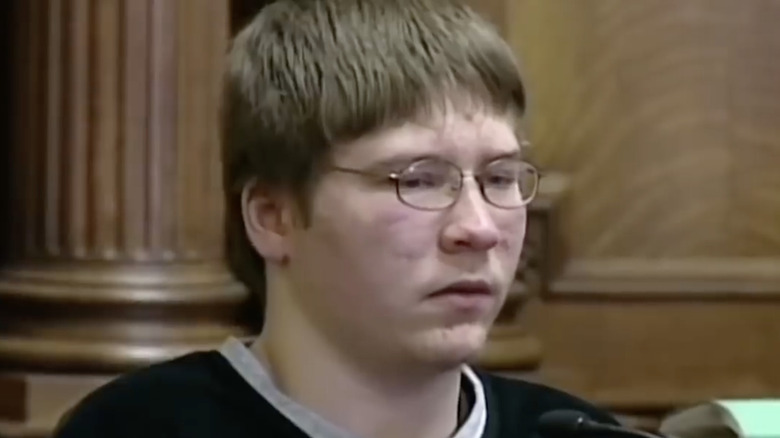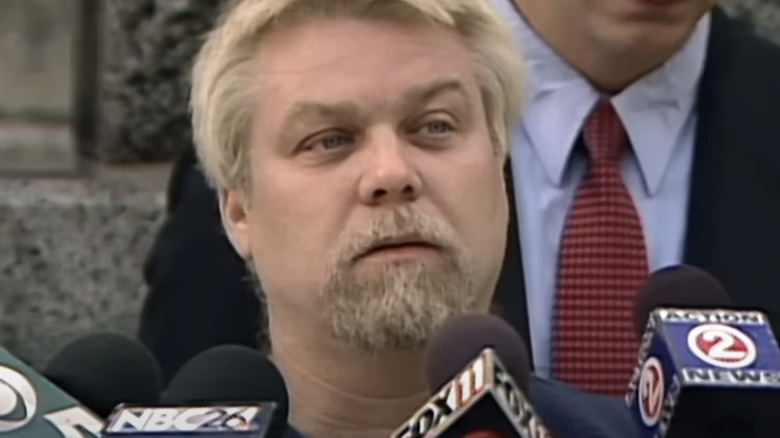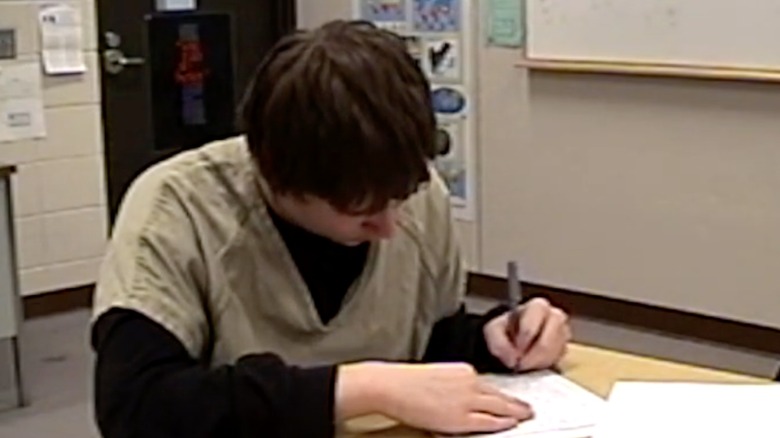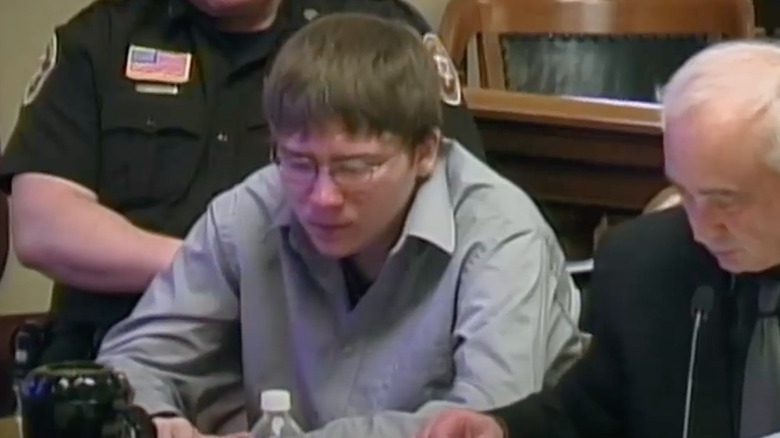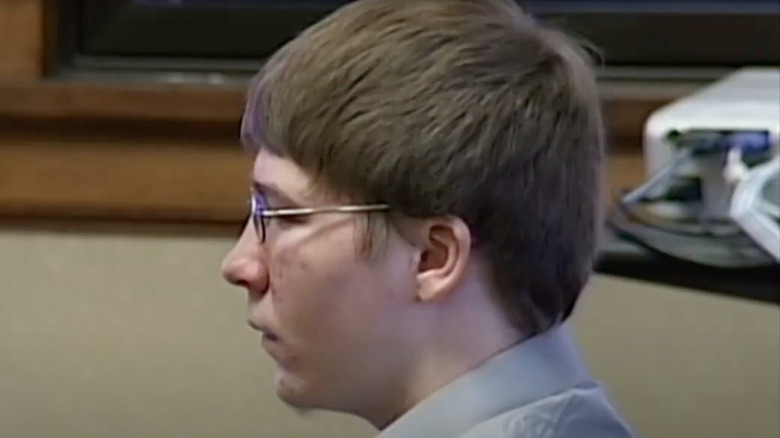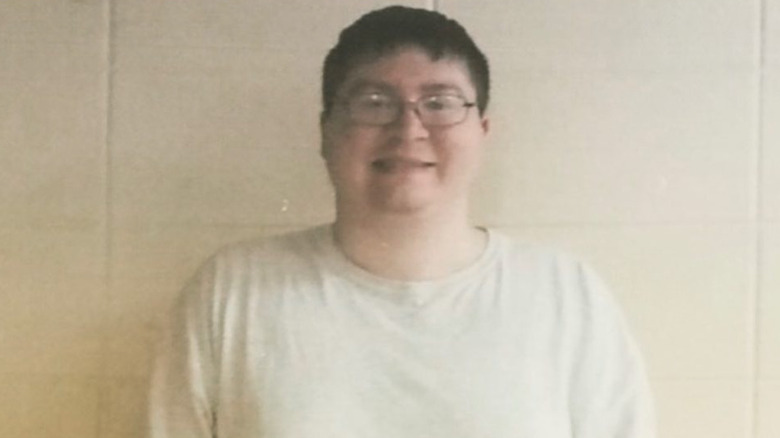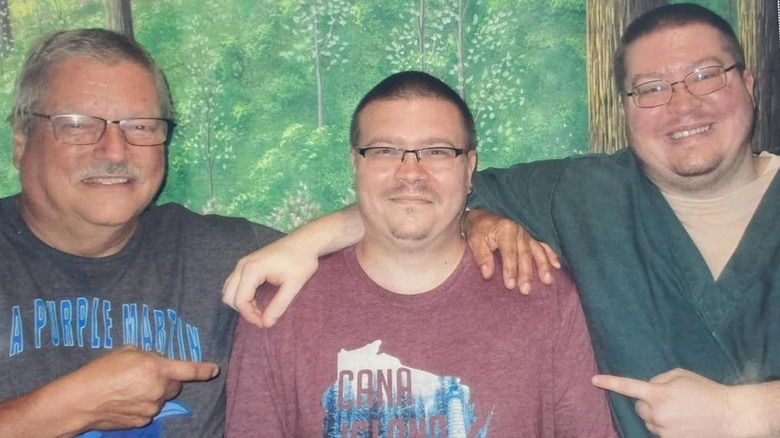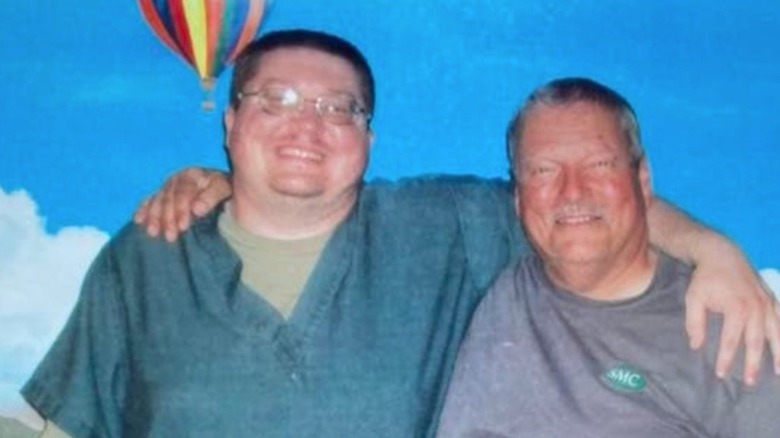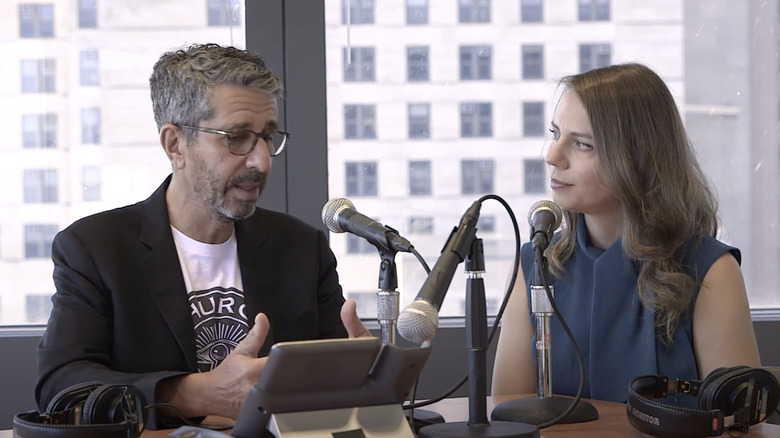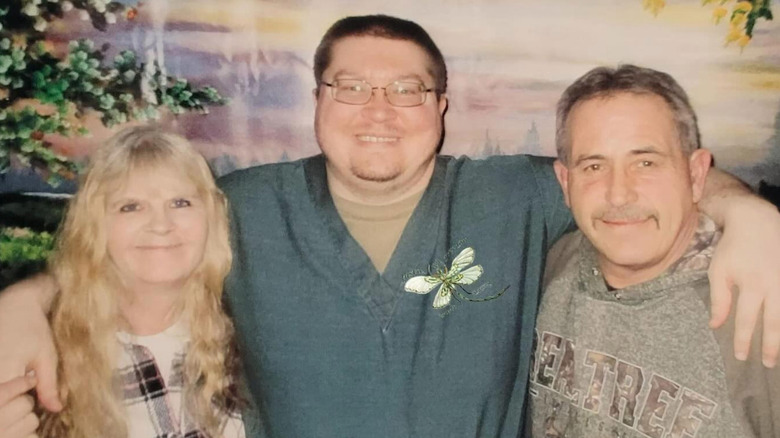What Happened To Brendan Dassey From Netflix's Making A Murderer?
The following article mentions murder and sexual assault.
In the 2015 Netflix series "Making a Murderer," viewers were introduced to Brendan Dassey, a 16-year-old in Wisconsin who gave a controversial confession. The then-high schooler was arrested in 2006 for participating in the rape and murder of photographer Teresa Halbach.
Halbach's remains and vehicle were found on the property of Steven Avery, Dassey's uncle. Halbach was visiting the property on Halloween in 2005 to take pictures of a van for Auto Trader magazine; whether or not she ever left the property is where stories differ. Dassey and Avery's convictions and imprisonments garnered national attention as allegations of coercion, tampered evidence, and corrupt officers came up during the trials.
Like the Netflix doc about the Chris Watts case, the series about the rumors and tragedies surrounding the Murdaugh family, the docuseries about JonBenet Ramsey's murder, and the series about the events leading up to Scott Peterson's incarceration, "Making a Murderer" garnered widespread attention. The case was covered on true crime podcasts, and each episode reportedly pulled in millions of viewers. At the end of the last season, which was released on October 18, 2018, Dassey, Avery, and members of their family were still fighting to prove their innocence. Here's what you need to know about the history of his case, as well as everything that's happened to Dassey since Season 2 of Netflix's "Making a Murderer."
His uncle's lawsuit against county police overlapped with the murder investigation
Before Brendan Dassey was born, another member of his family was wrongfully convicted of sexual assault and attempted murder. After spending 18 years in prison, Steven Avery, Dassey's uncle, was exonerated in 2003 when DNA testing confirmed someone else was the assailant. In 2004, he filed a $36 million civil lawsuit against Manitowoc County.
The following year, Avery became the prime suspect for a rape and murder investigation in the same county where his previous arresting officer, Kenneth Petersen, was now the sheriff. At the start of the investigation into Teresa Halbach's death, Avery was arrested in November 2005 for possessing firearms as a felon. In February 2006, authorities announced that his lawsuit against the county was settled, with him receiving $400,000.
Investigators searched Avery's property for days at a time on two separate occasions. Evidence found on the property included Halbach's vehicle, her car key, bullet shell casings, and Avery's blood inside the vehicle. Officials also interviewed family members like Dassey, who all lived within eyeshot of Avery's trailer and salvage yard.
Brendan Dassey confessed during his fifth interview with police
Police questioned Brendan Dassey several times before his arrest. During the first interview, Dassey told police Teresa Halbach left the salvage yard, and his uncle went in his trailer. However, the officers took issue with Dassey's version of events. "She didn't leave. Brendan, she didn't leave. ... Where did she go?...you're not tellin' me everything, I don't believe," said Detective Baldwin, according to the official interview transcript. Dassey was questioned again a few days later about whether or not he was involved in the attempted disposal of Halbach's body, and then again after that.
Dassey was charged on March 2, 2006, the day after his fifth interview with police. During the interview, officers questioned Dassey, who was 16 years old, for hours, apparently encouraging him to agree with their allegations. Dassey eventually gave what his lawyers called a guided confession. Originally, the teen told officers that he was home playing video games during the time that Halbach was killed. However, at some point during the interview, his story changed, and he said he did go to Avery's trailer that day. He then told detectives that he and his uncle both sexually assaulted the victim before killing her. Dassey recanted this confession, claiming he just said what he thought the officers wanted him to say.
On May 12, 2006, Dassey was asked by private investigator Michael O'Kelly to look at crime scene photos, draw pictures related to the murder, and write a confession. Dassey, whose attorney was not present, appeared to maintain his innocence, but his account changed throughout the questioning. Despite the inconsistencies in the teen's story and the methods used during interrogations, these apparent confessions played a pivotal role in the conviction of Dassey and his uncle.
The circumstances surrounding Brendan Dassey's confession were called into question
Brendan Dassey's first confession tape is one of the most controversial pieces of the investigation. He was not only a minor, but there was no guardian or attorney present during any of his interviews to protect his rights. Dassey's school records also showed that he has a language-based disability, and his team has posited the ways in which this might impact interrogations. Legal experts featured in "Making a Murderer" claimed that investigators not only fed Dassey specific details about the crime but guided him to agree with what they suspected happened. Defense attorneys also argued that the evidence at the crime scene didn't match his story. Though Dassey recanted his confession, parts of it were still used in the trial.
Steven Avery has maintained his own innocence over the years, and he and his attorneys claim that Manitowoc County law officials are framing Avery in retaliation for his wrongful conviction lawsuit. In 2007, he was found guilty of first-degree intentional homicide and being a felon in possession of a firearm. He was sentenced to life in prison without parole. The same year, Brendan Dassey was convicted of first-degree intentional homicide, second-degree sexual assault, and mutilation of a corpse. Dassey was sentenced to life in prison without the possibility of parole for 41 years.
His legal team asked the Supreme Court to hear his appeal case
In 2016, a federal judge ruled Brendan Dassey's confession was involuntary and overturned his conviction. Per NPR, the judge wrote, "Especially when the investigators' promises, assurances, and threats of negative consequences are assessed in conjunction with Dassey's age, intellectual deficits, lack of experience in dealing with the police, the absence of a parent, and other relevant personal characteristics, the free will of a reasonable person in Dassey's position would have been overborne."
An appeals panel upheld that decision, but the full Seventh Circuit Court of Appeals reversed it, citing that there was nothing "clearly erroneous" in the facts on which the conviction was based. In February 2018, Dassey's attorneys filed a petition for a writ of certiorari with the U.S. Supreme Court, requesting that the court review his case. The Supreme Court denied the request to consider the appeal.
"The video of Dassey's interrogation shows a confused boy who was manipulated by experienced police officers into accepting their story of how the murder of Teresa Halbach happened," Dassey's attorney Laura Nirider said in a statement obtained by NPR. "By the end of the interrogation, Dassey was so confused that he actually thought he was going to return to school after confessing to murder." The Supreme Court does not provide reasons for denied petitions.
Brendan Dassey petitioned for executive clemency
On October 2, 2019, Brendan Dassey and his lawyers submitted a request to Wisconsin Governor Tony Evers for executive clemency. The legal team's request was supported with letters from Northwestern Pritzker School of Law and a handwritten letter from Dassey. The then-28-year-old wrote, "I am writing to ask for a pardon because I am innocent and want to go home. If I would get to go home, I would like to get a job involving video games...Take care and until next time. Love the complete and innocent, Brendan Dassey"
On December 21, 2019, Governor Evers denied the pardon request because it did not meet the criteria, as Dassey has not completed his prison sentence and must register as a sex offender. Per WPR, Evers refused to consider shortening Dassey's sentence. "The courts have failed Dassey repeatedly and at every level," Avery's attorneys Dean Strang and Jerry Buting wrote in a response letter. "We ask you to exercise the power that only you have: to free him. We ask you to do it now."
Dassey's attorneys also issued a statement asking for commutation. They also claimed the Wisconsin Pardon Advisory Board did not fairly review the petition before denying it."[Gov. Evers] does have the power to issue commutations under the Wisconsin Constitution and should do so when, as here, courts fail to deliver justice," wrote Nirider and Drizin (via TMJ4). "Our partners around the country stand ready to work with the Governor to develop an appropriate process for the review of commutation petitions."
Support for Brendan Dassey continues to grow
Although Brendan Dassey remains in jail, he has garnered international support, and his case has had a historically significant impact on interrogation methods. Illinois and California have passed laws regarding the deception of minors and legal representation during interrogations. Furthermore, Dassey's confession tapes have been used to show police officers the wrong way to interview minors. Organizational advocates include The Innocence Project and Northwestern Pritzker School of Law.
Numerous groups and petitions have been created in support of Dassey. Some supporters, such as Rebecky Nash, have even visited him in prison. As she wrote in a blog post, "Hugging him warmed my heart. Watching him hug my friends, and his mother, also warmed my heart...the thought of leaving him, an innocent man, in a place filled with criminals made me feel sick inside."
There's also the Brendan Dassey Project, which encourages people to write to Dassey and advocate for his freedom by writing to the governor. They also regularly post updates from Dassey and his family. In March 2025, the organization's Facebook page shared a message from Dassey to his advocates: "Please tell everyone that I said hi, that I love them and that I appreciate all the love, care, support and everything they have been doing for me."
Brendan Dassey was rewarded for good behavior and often has visitors
Brendan Dassey has been incarcerated since 2007. He began his sentence at Columbia Correctional Institution, a maximum-security prison in Wisconsin. In April 2019, he was transferred to Oshkosh Correctional Institution, a medium-security facility. As lawyer Laura Nirider explained on an episode of NowThis' "Wrongful Conviction with Jason Flom" podcast, Dassey earned an early transfer out of maximum security prison for good behavior. Most of what's known about his life behind bars comes from his family and supporters. Dassey's mother, father, and stepfather visit him behind bars and occasionally share photos they've taken with him.
In Rebecky Nash's aforementioned blog post about her visit with Dassey, she shared that her visit made her all the more confident that he shouldn't be behind bars. "This experience was powerful and motivating for me. He needs freedom," she wrote. "He does not belong in prison, no matter how nice the food can be in the visitors room. Brendan Dassey should not have to worry about how long his hugs are, or what he can wear, what he can listen to, watch, or read. It relit a fire for me."
In the aforementioned podcast episode, Dassey shared that he's received letters of support from people around the world. When asked about those who continue to support him, he said, "I appreciate everything they're doing for me ... Just keep fighting for me."
Brendan Dassey did his first and only prison interview in 2019
In the aforementioned episode of "Wrongful Conviction with Jason Flom," Laura Nirider was joined by her client, Brendan Dassey. The podcast, which is a true crime podcast hosted by founding member of the Innocence Project Jason Flom, features interviews with incarcerated people who maintain their innocence. As of this writing, this is Dassey's only interview from prison.
In the interview, Nirider and Flom discussed what happened during Dassey's confession. Dassey also shared what his life is like behind bars. He said that after breakfast and lunch, he spends time in what he referred to as the "day room." "I either play cards in the day room and then email my family, just hang out with the guys here that I consider my friends," he said. When asked what has helped him keep his head up day after day, Brendan replied, "Mostly having my family support me and having my back."
Nirider also made it a point to note that Dassey has made an effort to assist others at the Columbia Correctional Institution and his current facility, Oshkosh Correctional Institution. His jobs have included helping inmates who have mobility issues get around the prison. During the interview, Dassey also said that if he could have a superpower, he'd want the ability to heal others. "Well, I just like helping people, so I wanted to help other people in the world," Dassey said.
What's next for Brendan Dassey
Brendan Dassey has exhausted his judicial appeals. His only remaining chances for early release are executive clemency, which he can file for again, or by association, if Steven Avery is vindicated. Otherwise, Dassey will remain in prison. He won't be eligible for parole until he's 59 years old, and he must maintain good conduct for the rest of his required sentence to be eligible for parole. Once he applies for parole, his file will be reviewed by a parole board or examiner. Then there will be a hearing before a board, where Dassey will have to discuss what happened during the case and his plans for life after release, before a final decision is made.
While "Making a Murderer" created widespread interest in his case, Dassey hasn't actually seen the docuseries — and it sounds like he is fine with that. In the aforementioned 2019 episode of "Wrongful Conviction with Jason Flom," he shared that even if he did have access to the Netflix show, he isn't so sure he'd view it. "You know, more or less because I lived it," he said. "So why would I want to watch it again?" As of this writing, there is no word on whether or not there are plans for a third season of "Making a Murderer."
If you or anyone you know has been a victim of sexual assault, help is available. Visit the Rape, Abuse & Incest National Network website or contact RAINN's National Helpline at 1-800-656-HOPE (4673).
